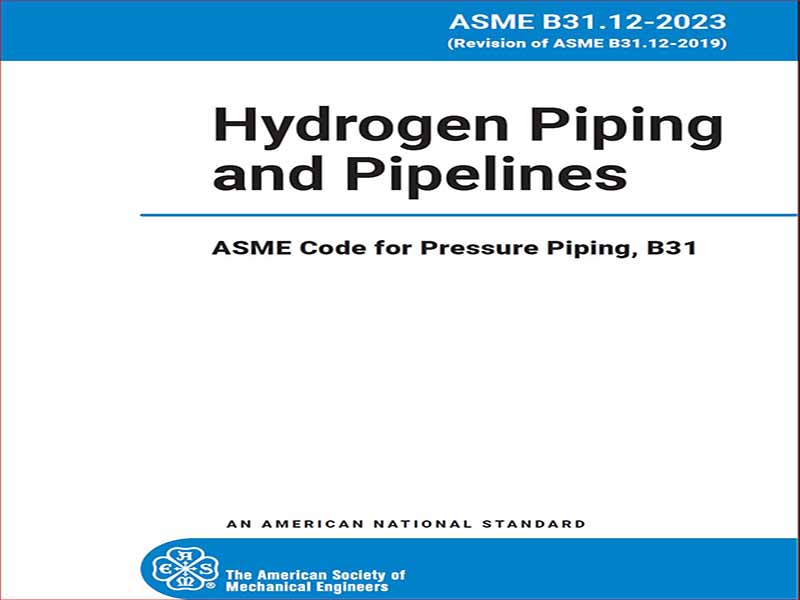- عنوان کتاب: Hydrogen Piping and Pipelines
- نویسنده: THE AMERICAN SOCIETY OF MECHANICAL ENGINEERS
- حوزه: لوله کشی
- سال انتشار: 2023
- تعداد صفحه: 270
- زبان اصلی: انگلیسی
- نوع فایل: pdf
- حجم فایل: 8.37 مگابایت
کد ASME B31 برای لوله کشی تحت فشار شامل تعدادی بخش است که به صورت جداگانه منتشر شده است، که هر کدام یک استاندارد ملی آمریکا هستند، تحت هدایت کمیته ASME B31، کد برای لوله کشی تحت فشار. قوانین مربوط به هر بخش، انواع تاسیسات لوله کشی در نظر گرفته شده در طول توسعه آن را به شرح زیر منعکس می کند: B31.1 لوله کشی برق: لوله کشی که معمولاً در ایستگاه های تولید برق، در کارخانه های صنعتی و سازمانی، سیستم های گرمایش زمین گرمایی، و گرمایش مرکزی و منطقه ای یافت می شود. سیستم های خنک کننده B31.3 لوله کشی فرآیند: لوله هایی که معمولاً در پالایشگاه های نفت یافت می شوند. تأسیسات تولید نفت و گاز طبیعی در خشکی و فراساحل؛ کارخانه های شیمیایی، دارویی، نساجی، کاغذ، فرآوری سنگ معدن، نیمه هادی ها و گیاهان برودتی. تاسیسات فرآوری مواد غذایی و آشامیدنی؛ و کارخانهها و پایانههای فرآوری مرتبط B31.4 سیستمهای حمل و نقل خط لوله برای مایعات و دوغاب: لولههای انتقال محصولاتی که عمدتاً بین کارخانهها و پایانهها و داخل پایانهها مایع هستند، ایستگاههای پمپاژ، تنظیم و اندازهگیری B31.5 لولهکشی تبرید: لولهکشی برای مبردها و ثانویه خنککنندهها B31.8 سیستمهای لولهکشی انتقال و توزیع گاز: لولهکشی که محصولاتی را حمل میکند که عمدتاً گاز بین منابع و پایانهها هستند، از جمله ایستگاههای کمپرسور، تنظیم کننده و اندازهگیری. و خطوط لوله جمعآوری گاز B31.9 خدمات ساختمانی لولهکشی: لولهکشی معمولاً در ساختمانهای صنعتی، سازمانی، تجاری و عمومی و در خانههای چند واحدی یافت میشود که نیازی به محدوده اندازه، فشار و دماهای تحت پوشش B31 ندارد. 1 B31.12 لولهکشی و لولههای هیدروژن: لولهکشی در خدمات هیدروژن مایع و گاز، و خطوط لوله که مخلوطهای هیدروژن و هیدروژن گازی را مدیریت میکنند. از این پس، در این مقدمه و در متن این کد بخش B31.12، جایی که کلمه Code بدون شناسایی خاص استفاده می شود، به معنای این بخش کد است. این مسئولیت مالک است که بخش کدی را انتخاب کند که تقریباً برای نصب لولهکشی پیشنهادی کاربرد دارد. عواملی که باید توسط مالک در نظر گرفته شود شامل محدودیتهای بخش کد، الزامات حوزه قضایی، و قابلیت کاربرد سایر کدها و استانداردها است. تمام الزامات مربوط به بخش کد انتخاب شده باید برآورده شود. برای برخی از نصب ها، ممکن است بیش از یک بخش کد برای بخش های مختلف نصب اعمال شود. مالک همچنین مسئول تحمیل الزامات تکمیلی نسبت به بخش کد انتخابی، در صورت لزوم، برای اطمینان از لوله کشی ایمن برای نصب پیشنهادی است. برخی از لولهکشیها در یک تأسیسات ممکن است مشمول کدها و استانداردهای دیگری باشند، از جمله، اما نه محدود به – کد ملی گاز سوخت ANSI Z223.1/NFPA 54: لولهکشی گاز سوخت از نقطه تحویل تا اتصال هر دستگاه مصرف سوخت – استانداردهای حفاظت از آتش NFPA: سیستمهای حفاظت از آتش با استفاده از آب، دی اکسید کربن، هالون، فوم، مواد شیمیایی خشک و مواد شیمیایی مرطوب – NFPA 99 امکانات مراقبتهای بهداشتی: سیستمهای گاز پزشکی و آزمایشگاهی – کدهای ساختمان و لولهکشی، در صورت لزوم، برای گرم و سرد آشامیدنی آب، و برای سیستم های فاضلاب و زهکشی این آیین نامه الزامات مهندسی را که برای طراحی، ساخت، بهره برداری و نگهداری ایمن لوله کشی تحت فشار ضروری تشخیص داده می شود، مشخص می کند. در حالی که ایمنی ملاحظات اساسی است، این عامل به تنهایی لزوماً بر مشخصات نهایی برای نصب یا عملیات لوله کشی حاکم نیست. کد یک کتابچه راهنمای طراحی نیست. بسیاری از تصمیماتی که باید برای ایجاد یک نصب لوله کشی ایمن و حفظ یکپارچگی سیستم گرفته شود، به طور دقیق در این کد مشخص نشده است. کد به عنوان جایگزینی برای قضاوت مهندسی صدا توسط مالک و طراح عمل نمی کند. تا حد ممکن، الزامات کد برای طراحی بر اساس اصول و فرمول های اولیه طراحی بیان شده است. این موارد در صورت لزوم با الزامات خاص تکمیل می شوند تا از اجرای یکنواخت اصول و هدایت انتخاب و کاربرد عناصر لوله کشی اطمینان حاصل شود. این کد طرحها و شیوههایی را که به عنوان ناامن شناخته میشوند، ممنوع میکند و حاوی هشدارهایی است که در آن احتیاط، اما نه ممنوعیت، ضروری است.
The ASME B31 Code for Pressure Piping consists of a number of individually published Sections, each an American National Standard, under the direction of ASME Committee B31, Code for Pressure Piping. Rules for each Section reflect the kinds of piping installations considered during its development, as follows: B31.1 Power Piping: piping typically found in electric power-generating stations, in industrial and institutional plants, geothermal heating systems, and central and district heating and cooling systems B31.3 Process Piping: piping typically found in petroleum refineries; onshore and offshore petroleum and natural gas production facilities; chemical, pharmaceutical, textile, paper, ore processing, semiconductor, and cryogenic plants; food and beverage processing facilities; and related processing plants and terminals B31.4 Pipeline Transportation Systems for Liquids and Slurries: piping transporting products that are predominately liquid between plants and terminals and within terminals, pumping, regulating, and metering stations B31.5 Refrigeration Piping: piping for refrigerants and secondary coolants B31.8 Gas Transmission and Distribution Piping Systems: piping transporting products that are predominately gas between sources and terminals, including compressor, regulating, and metering stations; and gas-gathering pipelines B31.9 Building Services Piping: piping typically found in industrial, institutional, commercial, and public buildings, and in multi-unit residences, which does not require the range of sizes, pressures, and temperatures covered in B31.1 B31.12 Hydrogen Piping and Pipelines: piping in gaseous and liquid hydrogen service, and pipelines handling gaseous hydrogen and gaseous hydrogen mixtures This is Code Section B31.12, Hydrogen Piping and Pipelines. Hereafter, in this Introduction and in the text of this Code Section B31.12, where the word Code is used without specific identification, it means this Code Section. It is the owner’s responsibility to select the Code Section that most nearly applies to a proposed piping installation. Factors to be considered by the owner include limitations of the Code Section, jurisdictional requirements, and the applicability of other codes and standards. All applicable requirements of the selected Code Section shall be met. For some installations, more than one Code Section may apply to different parts of the installation. The owner is also responsible for imposing requirements supplementary to those of the selected Code Section, if necessary, to assure safe piping for the proposed installation. Certain piping within a facility may be subject to other codes and standards, including but not limited to – ANSI Z223.1/NFPA 54 National Fuel Gas Code: piping for fuel gas from the point of delivery to the connection of each fuel utilization device – NFPA Fire Protection Standards: fire protection systems using water, carbon dioxide, halon, foam, dry chemicals, and wet chemicals – NFPA 99 Health Care Facilities: medical and laboratory gas systems – building and plumbing codes, as applicable, for potable hot and cold water, and for sewer and drain systems The Code specifies engineering requirements deemed necessary for safe design, construction, operation, and maintenance of pressure piping. While safety is the overriding consideration, this factor alone will not necessarily govern the final specifications for any piping installation or operation. The Code is not a design handbook. Many decisions that must be made to produce a safe piping installation and to maintain system integrity are not specified in detail within this Code. The Code does not serve as a substitute for sound engineering judgment by the owner and the designer. To the greatest possible extent, Code requirements for design are stated in terms of basic design principles and formulas. These are supplemented as necessary with specific requirements to ensure uniform application of principles and to guide selection and application of piping elements. The Code prohibits designs and practices known to be unsafe and contains warnings where caution, but not prohibition, is warranted.
این کتاب را میتوانید از لینک زیر بصورت رایگان دانلود کنید:
Download: Hydrogen Piping and Pipelines



































نظرات کاربران